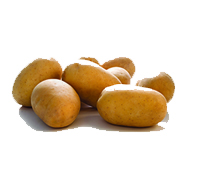
BORYNA – PMHZ breeding – medium-early variety, creamy flesh, medium water requirements and low soil requirements, medium resistance to metribuzin; days of vegetation: 120; yield t / ha: 44.2; Starch%: 20.3

GLADA – PMHZ breeding – medium-early variety, light-yellow flesh, low water and soil requirements, medium sensitivity to methribuzin, growing days 138, yield t / ha 44.2; starch% 19.6.

MIESZKO – PMHZ breeding – medium-early variety, light-yellow flesh, medium water requirements, low soil requirements, medium resistance to methribuzin, growing days: 115; yield t / ha: 42.8; starch%: 19.8

NOVANO – Dr Niehoff kennel – Germany. Starch variety, medium late, starch content over 20%. Round-oval, even tubers, high yielding potential. A variety that preserves well. Recommended by Emsland and Avebe starch plants. It can be planted in the 3rd decade of March, of course, in dry, heated soil. Minimum cast of 45,000 plants per ha. It requires increased nitrogen fertilization – even up to 180 kg N (you can use 70% of the dose before planting and 30% before closing the rows). The variety is insensitive to methribuzin. Resistant to nematodes, Ro 1,2,3,4, Pa 2 + 3, to cancer – patotypes 1,2,6,18. Very low susceptibility to virus Y, rhizoctoniosis, leaf roll, black leg.

Tomensa – Europlant breeding – an early starch variety with a certain and high starch content. Due to the fact that it binds an average number of tubers, it should be planted in a row spacing
75 cm, every 28 – 30 cm in a row (about 44-48 thousand plants / ha). Tomensa ties the tubers deeper,
therefore it is recommended to plant it a bit shallower (1-2 cm). Due to its firm dormancy of sprouts,
it is recommended to stimulate before planting. The starch content is on average 19-21%. Is
is a variety that preserves very well without losing its parameters.
